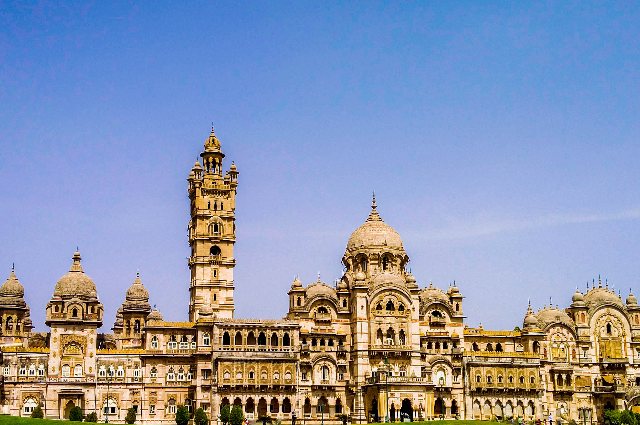Nestled near the renowned Maharaja Sayajirao University of Baroda, the Sayaji Rao Palace, also known as the Lakshmi Vilas Palace, stands as a testament to the grandeur and opulence of the erstwhile princely state of Baroda. The palace is not only a significant architectural landmark but also a symbol of the rich cultural heritage of Vadodara. Its history is intertwined with the legacy of one of the most progressive rulers of India, Maharaja Sayajirao Gaekwad III.
The Genesis of Sayaji Rao Palace
The Lakshmi Vilas Palace was commissioned by Maharaja Sayajirao Gaekwad III in 1890 and completed in 1894. Designed by the prominent British architect Charles Mant, the palace was constructed in the Indo-Saracenic style, which amalgamates elements of Indian, Islamic, and Western architectural designs. This style was prevalent during the British Raj and was known for its grandeur and intricate detailing.
The palace was named after the Maharaja's second wife, Maharani Chimnabai, who was affectionately called Lakshmi Bai. Sayajirao Gaekwad III was known for his progressive vision and contributions to education, infrastructure, and social reforms, and the construction of this palace reflected his desire to create a residence that would symbolize the prosperity and cultural richness of his state.
Architectural Marvel
Lakshmi Vilas Palace is reputed to be four times the size of Buckingham Palace, underscoring its vastness and magnificence. Spread over an area of 500 acres, the palace complex includes a number of buildings, notably the Motibaug Palace and the Maharaja Fateh Singh Museum, as well as a golf course.
The palace itself is a masterpiece, featuring European stained glass windows, mosaic decorations, and a majestic Darbar Hall, which is adorned with Venetian chandeliers and Belgian stained glass windows. The Darbar Hall is also equipped with a grand piano, and its walls are decorated with intricate mosaics and marble patterns. The palace's interiors are a blend of different styles and influences, reflecting the eclectic tastes of the Gaekwads.
Historical Significance
Maharaja Sayajirao Gaekwad III was a visionary leader who played a pivotal role in the development of Baroda (now Vadodara). His reign marked significant progress in education, social reforms, and infrastructure development. He established the Maharaja Sayajirao University, which is one of the leading educational institutions in India today.
The Lakshmi Vilas Palace was not just a royal residence; it was a hub of cultural and political activity. The Maharaja hosted numerous dignitaries, both Indian and European, fostering diplomatic relations and cultural exchanges. The palace witnessed important decisions and events that shaped the history of Baroda and its integration into modern India.
Legacy and Preservation
Today, the Lakshmi Vilas Palace remains a significant tourist attraction and a symbol of Vadodara's heritage. The Maharaja Fateh Singh Museum, housed within the palace complex, showcases an extensive collection of artworks, including paintings by Raja Ravi Varma, European sculptures, and other artefacts that reflect the rich history and cultural heritage of the Gaikwad.
The palace grounds are meticulously maintained, and the golf course is still in use, offering a glimpse into the luxurious lifestyle of the royal family. The current descendants of the Gaekwad family reside in a part of the palace, maintaining the legacy of their illustrious ancestors.
A Glimpse into Royal Life
Imagine stepping back in time to the early 20th century, walking through the grand corridors of Lakshmi Vilas Palace. The air would be filled with the scent of fresh flowers from the palace gardens, and the halls would echo with the sounds of classical Indian music, as musicians played for the royal family and their guests. The Maharaja, dressed in regal attire, would hold court in the Darbar Hall, discussing matters of state with his ministers and welcoming foreign dignitaries with grace and hospitality.
Life in the palace was a blend of tradition and modernity. The royal family upheld ancient customs and rituals while embracing new ideas and technologies. The palace was equipped with the latest amenities of the time, including elevators, telephones, and even an internal railway system to transport goods and people across the vast estate.
Conclusion
The Sayaji Rao Palace, with its rich history and architectural splendour, stands as a proud emblem of Vadodara's royal heritage. It is a reminder of a bygone era when visionary leaders like Maharaja Sayajirao Gaekwad III shaped the future of their states with wisdom and foresight. Today, as visitors walk through the grand halls and lush gardens of Lakshmi Vilas Palace, they are transported to a time of regal opulence and cultural richness, experiencing firsthand the legacy of one of India's most enlightened rulers.

